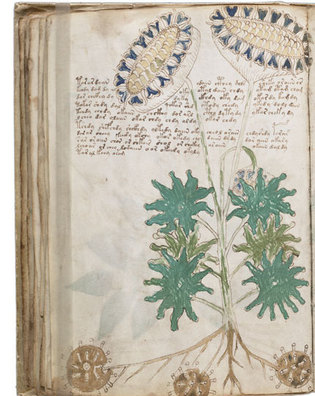 loading
loading
FindingsThe Voynich mysteryNew attempts to decode a mysterious manuscript.  Beinecke Rare Book and Manuscript LibraryThe Voynich Manuscript is in an unknown, undeciphered language. View full imageEveryone loves a good secret, and the Voynich Manuscript might be one of the world’s greatest. Housed at Yale’s Beinecke Rare Book and Manuscript Library since 1969, the 240-page volume is thought to date to the fifteenth or sixteenth century—though no one knows for sure. It’s written in a script and language found nowhere else, and its pages are ornately illustrated with drawings that range from the practical—plants, animals, suns, and moons—to the bizarre: naked women in pools of green liquid. The manuscript is named after Wilfrid Voynich, a rare-book merchant who bought it from a Jesuit college in 1912. His widow sold it to a bookseller who later gave it to Yale. Many have tried to crack its code, none successfully. In January, Stephen Bax, a professor of applied linguistics at the University of Bedfordshire, offered what he calls a “provisional partial decoding” of the manuscript. He started with illustrations of seven plants (and one constellation) previously identified by other scholars and then zeroed in on the word in the accompanying text that he believed represented the plant’s name. For example, on a page with a plant identified as juniper, he found a word that looked like “oror”—similar to “arar,” the Arabic word for juniper. He then marked the symbols in the word “oror” as representing an “ah” and a “ra” sound. In all, Bax says, he was able to decipher 10 words and 14 symbols. Separately, two US botanists have a theory about the manuscript’s origins. Arthur Tucker, a Delaware State University botanist, and Rexford Talbert, a retired Department of Defense information technologist and botany lecturer, published an article in November positing that the manuscript comes from Mexico and is written in an extinct Aztec dialect. Tucker and Talbert say they have identified 37 of the manuscript’s 303 plants, as well as six animals and a mineral. Today, those species are native to the area bounded by Texas and California and as far south as Nicaragua. All three scholars say their work is incomplete and many mysteries remain. Still, Ray Clemens, curator for early books with the Beinecke Library, is skeptical. “I have e-mails every day from people who say they have decoded the Voynich,” he says.
The comment period has expired.
|
|